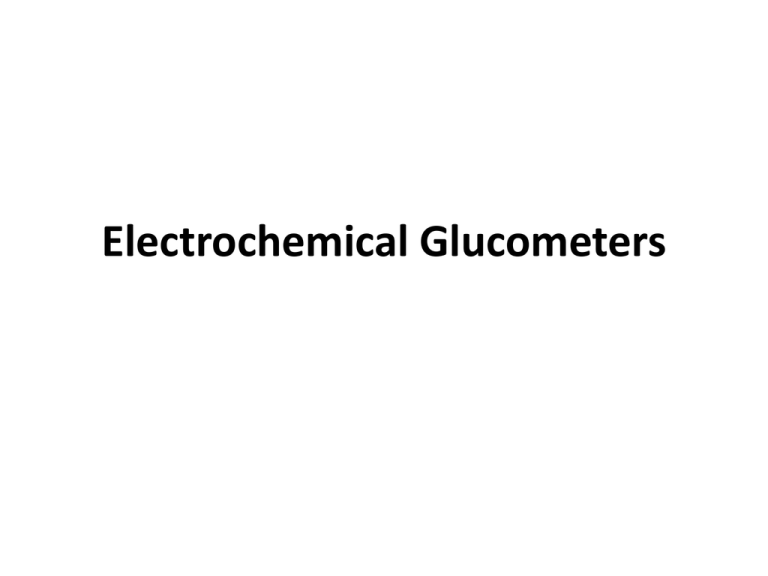this Lesson
advertisement

Electrochemical Glucometers Diabetes • Diabetes affects 17 million Americans and 171 million people worldwide. • Two Major Types – Type I: Pancreas produces very little or no insulin; affects younger patients – Type II: Pancreas does not produce enough insulin or does not use produced insulin effectively (insulin resistant); affect middle-aged to older patients – Other Types: Gestational Diabetes during pregnancy Blood Glucose • Insulin – hormone that circulates in the blood – helps body use and store glucose – Low levels of insulin: body cannot store glucose • After eating, blood glucose rises as food is broken down • High blood glucose levels damage the eyes, kidneys, nerves, and heart over time • Normal glucose levels: 82 to 110 mg/dL Management of Diabetes • Diet • Exercise • Oral Medication • Insulin Therapy: injection of exogenous insulin analogs when blood glucose levels are high Electrochemical Glucometers • Measure glucose in blood • At home testing requires minimal amounts of blood • Utilizes disposable electrochemical cell – electrical current is created from the oxidation of glucose Type I check 4 times/day Type II check 2 times/day Traditional Electrochemistry Components • Working electrode: Silver electrode H2 gas – Where reaction of interest takes place • Reference electrode: Standard hydrogen electrode • Measure current flowing between electrodes Cl- Ag+ Chemical Reactions OXIDATION OF GLUCOSE BY ENZYME glucose + GOD(ox) gluconolactone + GOD(red) glucose gluconolactone + 2e2e- + GOD(ox) GOD(red) D-glucose Glucose Oxidase (GOD) is an enzyme directly oxides Glucose REDUCTION OF ENZYME BY MEDIATOR GOD(red) + 2Fecp2R+ GOD(ox) + 2Fecp2R + 2H+ 2Fecp2R 2Fecp2R + 2eFerrocene monocarboxylic acid (Fecp2R) Mediator transports electrons to working electrode Test Strips •When blood added, glucose is oxidized by enzyme coated on working electrode •Voltage applied between working and reference electrode •Measure current between working and reference electrode Amperometric Analysis • Current measured 5-15 seconds after blood is drawn • Current levels directly proportional to glucose levels Calibration curve for glucose enzyme electrode in (*) argon, (0) air, and (+) oxygen-saturated buffer. Steady-state current was measured at 160 mV vs. SCE, pH 7.0, and 25 OC. Advantages Fast Disposable Strip No Instrument Contamination Disadvantages Discomfort of pricking finger Non-continuous measurement Implantable Glucose Sensor • Advantage: continuous glucose monitoring – Could be coupled with continuous subcutaneous insulin infusions • Problems: – Sensor stability – Calibration – Biocompatibility Recent Study Designed Implantable sensor recorded glucose values every 128 s Longest sensor (of 5 subjects) lasted 103 days in vivo!











